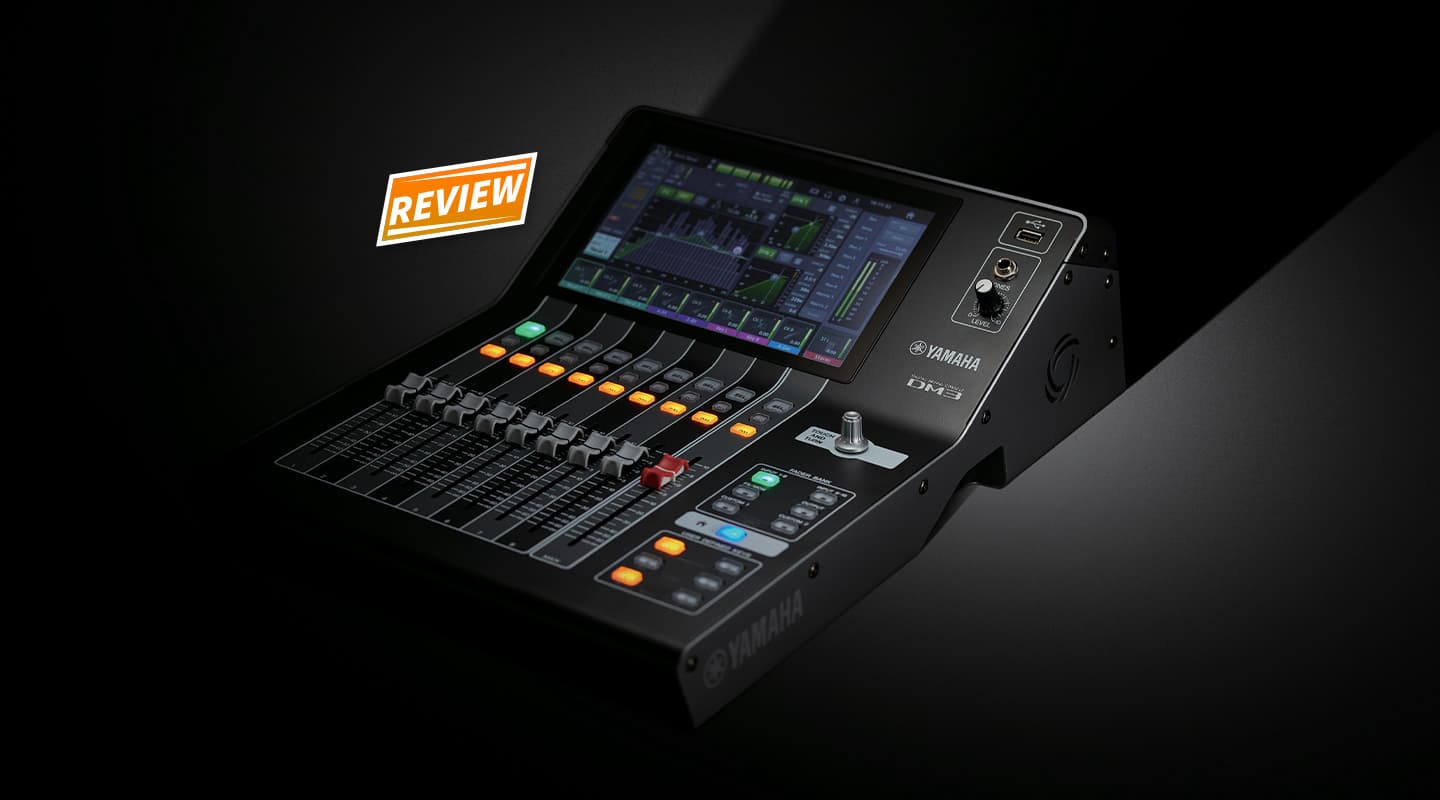
Review: Yamaha DM3
The new baby of Yamaha’s digital mixing family is no orphan. Mark Woods enthusiastically adopts the DM3.
Yamaha makes ‘action’ products. It must be a fun place to work – everything is fast or noisy. Early to embrace the new world of digital consoles, it remains at the forefront of this evolving technology with a range of state-of-the-art products of all sizes. The new entry-level Yamaha DM3 is a super-compact 96k digital console with a focused set of pro features and flexible workflows.
The DM3 is the baby of the Yamaha digital mixer family and, while it sure looks like a cut down DM7 (Yamaha’s new big dog on the block), its closest relatives are the Yamaha TF series consoles. Updated from the TF and assimilated into the current range of digital consoles, the DM3 is a modern mixing board. The nine-inch touchscreen dominates operations. It combines with one knob and a dozen buttons to control the 16 inputs and eight outputs. Nine physical faders mix the show.
LITTLE LARGE FORMAT
The DM3 is cute as a button. It weighs just 6.5kg and can be carried in one hand, but it still presents as a serious bit of gear when you’re standing behind it. The surface is inviting with its simple fader layout and single turn ’n’ push control knob. The screen is angled for easy viewing and touch. The screen content is simple to understand at a glance. A touch takes you deeper if you want more detail. The six Layer buttons and six User buttons are where you need them on the lower right. Build quality seems high, it looks great and feels real.
Designed as a reasonably-priced multi-purpose console, the DM3 competes with the other, popular budget mixers, firstly by offering Yamaha’s proven sound quality and 96k sampling. All else being equal, higher sampling rates fundamentally improve digital sound by using more ‘dots’ to describe the sound wave, especially at high frequencies. Zoom all the way in on a 10kHz sine wave sampled at 44.1kHz on your DAW and you’ll see what I mean – not many dots per wave. The downside of higher sampling rates used to be big files to process and store but that’s easy now and 96k looks to be the current pro standard. In use, it’s a subtle but not insignificant improvement and while even higher sampling rates are currently being used, we’re probably approaching the law of diminishing returns. Latency from input to mix out is an imperceptible 1.3ms.
SCREEN TIME
Then there’s the (relatively) large and responsive multi-touch screen. It’s fast and decisive to tap, and happy to support drag and pinch gestures. The on-screen faders also respond well to touch. The slide gesture is nicely weighted for enhanced control and accurate to within a couple of dB with my clumsy fingers. An overview of all current levels is up the top of the screen, in the strip with always-present functions – Scenes, Preferences, Patching, USB, Monitoring and more.
The complicated nature of digital mixing and the sheer quantity of stuff that can be presented simultaneously on a screen is pushing more functions onto screens and away from physical controls. It’s probably cheaper to make them too. You can, of course, go all the way and mix on an iPad or your phone but I don’t enjoy on-screen faders for active mixing, occasionally, perhaps, for a small adjustment or set- ’n’ forget gigs, but until Elon’s Neuralink catches on, nothing currently replaces hands-on proper 100mm faders.
Physical knobs are similarly better than virtual equivalents, especially for fine adjustments, but unlike faders they’re only used one at a time. I came to enjoy the single turn ’n’ push knob on the DM3, touching the screen and turning the knob is fast and accurate, pushing the knob to change its function is convenient… and you always know which knob to use.
NEED TO KNOW
Yamaha DM3
Digital Mixing Console
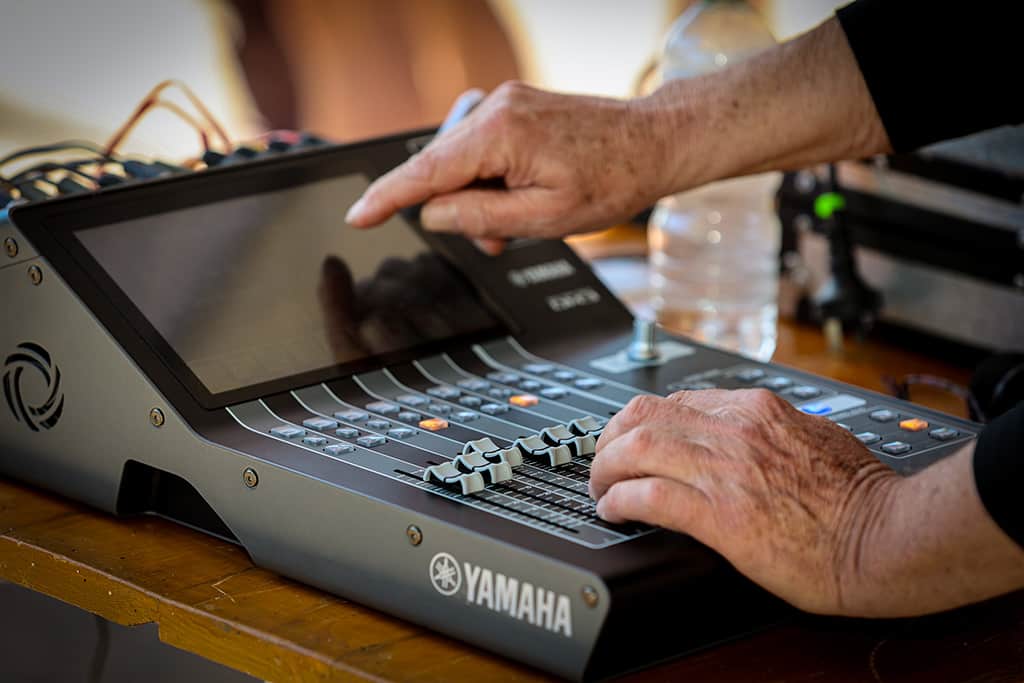
FAMILIARISATION TOUR
Using the DM3 for the first time requires less familiarisation than most and there are plenty of helpful features. This is when you notice the mixer’s TF series lineage: the one-knob EQ and compression functions, the presets and scenes. For those not familiar with the TF series, the consoles have a library with preset scenes for typical music/speech applications that give new users (or operators in a hurry) a helpful pre-patched starting point. Naming the channels on the DM3 with the virtual keyboard is simple and includes the choice of different languages. Channel colours are limited to eight and there’s not many instrument icons, there’s no tuba icon, for example (yes, I mixed a band with a tuba, and felt mildly dudded).
The 8+1 physical channels have the usual Sel/Cue/Mute buttons, while everything else you need is on the screen. Touching a box or an edit icon takes you there and activates the one-touch knob ready to tweak the level or main parameter. Touching again opens up more functions and options. Channel processing starts with a four-band parametric EQ, with separate HPF. The RTA integrated into the EQ section is not overbearing like some, and can be switched off, or switched to display a piano keyboard for reference. There are two dynamics processors, nominally set as a gate and as a compressor. GainFinder is a visual gain-setting helper. Each channel can be delayed. A multi-band compressor and de-esser are noticeable by their absence, perhaps being saved for an update.
ONE TOUCH, ONE ENCODER
When I first met Yamaha’s QuickPro Presets and One-Touch EQ/Compressor functions on the TF Series I thought they were gimmicky but after using them I came to appreciate how they are another control option rather than simply a shortcut for newbs. A library of QuickPro Presets gives typical EQ/comp settings for a long list of commonly used mics and DIs. The One-Knob function continuously varies how much of the suggested EQ or Comp settings get applied to the channel. The One-Touch EQ preset for an SM58, for instance, gives you increasing amounts of a simultaneous boost to the high-mid vocal range and reduction in the low-mids. The One-Touch compressor simultaneously adjusts the threshold; increases gain reduction; and raises the channel output level as more is applied. The settings make sense and it’s fun to audition the presets but in use I found I was often only wanting to change one parameter at a time and reverting to manual drive.
combination of Yamaha quality in a modern compact console, with an excellent touchscreen and real faders is a level above

EFFECTS & SENDS
Notably, there are only two effects. That’s okay by me – a reverb and a delay is enough for a 16-channel show. The effects include three versions each of Yamaha’s REV HD and REV R3 reverbs from the TF series, among a total of 18 different types of effects to choose from.
If the on-board effects aren’t enough or you’d like to use your fave recording plugins instead you can download VST Rack Elements that hosts Send/Return VST plugins.
The boxes in the Send section flip the faders to the six mix buses or matrix send levels. The mix busses (generally foldback) can also be accessed via Send From boxes on the input channels and the send level adjusted by the knob. The Mix Out channels get the same processing as the input channels less the separate HPF, but with the addition of a 31-band GEQ (limited to 15 bands at one time) that can be flipped onto the faders or controlled from the screen.
There are six fader layers on the DM3. The first two are the 16 input channels, the third is FX/MON channels, the fourth is the outputs. Layers 5 & 6 are custom layers you can populate on the fly and I used these a lot. Throwing the channels you need to ride onto one layer saves a lot of thinking. Below the Layer buttons reside six user-defined buttons that allow control of your choice of functions including Mute Groups, FX mutes, tap for delay and meter peak-hold. If the DM3 is used as a recording interface the user-defined buttons can control the transport functions of the host DAW.
GOTH BANJO MUSIC HALL
I’ve been using the DM3 for around three months by the time I put pen to paper for this review. It’s been handy. It can be anything from a nifty problem-solver to a fully-featured FOH or foldback mixer. The first time I took it out, I was using a 32-channel analogue system for the 2023 Maldon Gothic Festival and over the weekend the DM3 got used for recording the live acts, playing backing tracks, BGM between acts, and as an on-stage sub-mixer for a magic act.
The Guildford Banjo Jamboree is one my favourite annual events and I wanted to use the DM3 as FOH mixer in the Public Hall for the Friday bush dance and the main Saturday concerts. Starting from a Preset scene and tweaking it to suit the event was an easy way to get going and I was soon running all 16 channels in the house plus five sends of foldback. Running the PA subs from a mix out gave me good control of EQ and dynamics, plus delay, and saved packing a separate crossover.
The DM3 looked a little out of place at the traditional bush dance. People kept asking if I could watch TV on it, but I was happy with the sound in the room and found mixing quite enjoyable. The channel and output EQ options are precise and you get what you expect from them. The comps are normal – they do what they’re asked – perhaps without the character of favourite analogue devices (the high-end Rivage range has simulations of those) but they work. The FX are limited in number but they’re excellent quality. The physical faders are real but not very smooth, not like analogue faders. It’s more of a digital console issue rather than Yamaha’s, and could be a cost thing, but they’re noticeably notchy.
I also supply a system for the old gold-rush era Guildford Music Hall across the road. The guys mixing in there over the weekend noticed that I’d ‘gone digital’ in the main room. They had no complaints about the sound but were mighty relieved that I’d supplied a 16-channel analogue desk for them to use in the Music Hall. It might be different for the new kids but there are a lot of amateur/casual/senior mixers out there who freeze when they see digital consoles… even a nice friendly one like the DM3.
I make a simple recording of the concerts every year, usually onto a Zoom recorder from the mixing desk. Recording onto the DM3’s USB drive was easier, the recording/naming routine is foolproof, and the recorded sound quality is very good, although I’d prefer the recordings to be pre master bus EQ, or switchable, to avoid printing the house EQ. Something for a firmware update perhaps.

GOING PLACES
The Whole Loddon Love Tour saw the DM3 on a run of shows in flood-affected towns in the Loddon region of Victoria. Some were outdoor shows but others were small pubs with no dedicated FOH mix position. The 24-channel analogue desk and effects/drive racks I otherwise would have taken would have been hard to squeeze in. These small rooms made a good case for an iPad mixer but the DM3 was a better solution for me – it’s not wireless but it’s more precise to operate and it will fit in any space.
An outdoor school concert I do every year is a good test of how a digital console performs in daylight. One year I recall having children holding cardboard sheets above the console to try and create some shade because I couldn’t see the screen at all. That was under a gazebo too, it’s glary out here. The DM3 passed the test, with the brightness up full, I could see the screen quite well, and it’s got dark/light background screen modes with separate intensities for screen and panel, plus two custom banks to store your preferences.
A seven-piece cover band at the local sports club was probably about as big as you could fit into the 16 inputs but did demonstrate how capable the DM3 is with heavily processed pop bands, where I think digital consoles do their best work. The channels were all loaded up with no signs of protest and it remained easy enough to operate with a band that needed lots of FX and fader-riding. Clear displays of everything going on helps, the Custom Fader layers minimise fader flying.
GROUP THERAPY
There are a few things the DM3 doesn’t have. No DCAs – although you can make groups from the omni mix outs and route them back to the main outs, and there’s also a Channel Link page to create groups of linked channels that can have parameters changed simultaneously. There’s no talkback mic so you use up a channel to talk to stage. No auto mic mixer for corporate events. No multiband comps or de-esser. None of that really matters, it’s not competing on quantity of functionality, it’s the functionality of the package that’s important here and by that measure it punches well beyond its weight.
Apps include the offline DM3 Editor, a good way to learn the desk before you use it or to pre-plan shows, that can be saved and loaded when needed. DM3 StageMix is the app for iPad-only remote control. MonitorMix is available for Android as well.
All Yamaha gear seems inherently reliable, they make a lot of machines you don’t want to fail in the middle of a high speed corner (or equivalent) so they make them to work and last. Yamaha pioneered the development of digital consoles and while I still occasionally see tech riders specifying ‘no LS9s’ its current range from the DM3 up, are all leading-edge premium consoles.
SLIDING INTO THE DM
Given the quality, both physical and fidelity, the Yamaha DM3 seems like a bargain to me. There are cheaper options with similar channel counts, especially iPad-control systems, but the combination of Yamaha quality in a modern compact console, with an excellent touchscreen and real faders is a level above.
Potential customers for the DM3 include small-medium sized bands/duos/DJs, streamers and home/project recording studios. Portable PAs, where size and weight are important. Venues that use less than 16 channels looking for a plug ’n’ play replacement for their ageing analogue mixer, or any sort of corporate/educational setting. I want one.

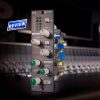
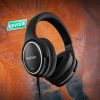




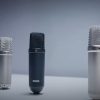


















Love Marks ‘Real World’ reviews.
Extremely informative.
And yeah, I want one.👍
Thank you for the review! I had the chance to try out the Yamaha DM3 together with the Yamaha Tio 1608-D2 stagebox, as I’ll be using this setup for an upcoming gig at a club. I was surprised to find that even though I have 16 inputs on the mixer and another 16 on the stagebox, I wasn’t able to patch all 32 channels into the mixer. Is this the correct behavior, or is there a way to access more than 16 channels? Thanks for your answer and best regards! Štěpán